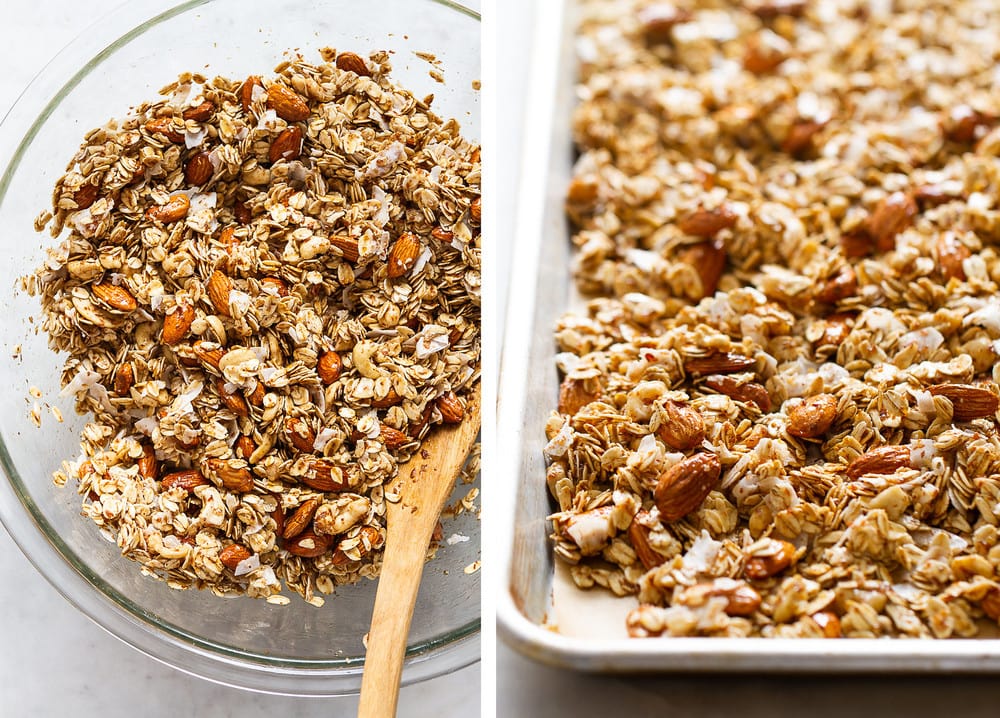Healthy Homemade Granola (Oil-Free)
Healthy Granola – The easiest, most delicious homemade granola recipe is made with oats, almonds, cashews, coconut, flaxseed meal, vanilla, spices, and naturally sweetened with maple syrup. It’s THE BEST!

This healthy homemade granola is gluten-free, oil-free, and amazingly delicious!
It’s toasty, crunchy, and easy to make. As an added bonus, about halfway through baking your home will be smelling wonderful!
Oh, and let’s not forget that it’s delicious, too – especially for breakfast with fresh fruit and non-dairy milk or yogurt. It’s my new favorite homemade granola cereal, and I think you’ll love it too!

Healthy Granola Ingredients
The ingredients for this easy granola recipe include simple, wholesome ingredients that you may already have on hand!
- Oats. Heart-healthy old-fashioned oats.
- Almonds. Use slivered almonds in place of whole, or rough chop whole almonds if you like
- Cashews. Use whole cashews or halves & pieces.
- Coconut. I used large coconut flakes, but shredded coconut works too.
- Flaxseed meal. Heart-smart flaxseeds help with clumping, but if you don’t have any flaxseed meal on hand, no worries, you’ll be fine without it.
- Pure maple syrup. My favorite natural sweetener!
- Vanilla. Adds a nice layer of flavor.
- Optional add-ins: cinnamon and a pinch of salt to bring out all the flavors. Add 1/2 – 1 cup of dried fruit once the granola has been pulled from the oven. A few dried fruits to use are raisins, dried blueberries, or cranberries.
This is a loose granola. For a clumpy style granola, try this Pumpkin Granola or Peanut Butter & Banana Granola Snack Clusters. It’s full of chunky clusters!

How To Make Homemade Granola
- In a large bowl, mix together the oats, almonds, cashews, coconut, flaxseed meal, maple syrup, vanilla, optional cinnamon, and a pinch of salt.
- Layer the granola on a rimmed baking sheet lined with parchment paper or silpat. Bake for 45 minutes at 300 degrees F, giving a thorough stir every 10 minutes or so.
And that’s it, now all you have to do is enjoy!

How To Store Granola
You can keep this healthy granola in a mason jar or an airtight container for 1 – 2 months (but I bet you’ll finish off before then!).
Serving Suggestions
Here are some of my favorite ways to enjoy this toasty, crunchy treat!
- Serve as a cereal with fresh fruit, non-dairy milk, or yogurt
- Top it on non-dairy ice cream
- Add a small handful on top of your favorite smoothies, smoothie bowls and shakes
- Or enjoy it by the handful as a quick snack

More Easy Granola Recipes!
Granola is easy to make and great for breakfast, as a snack, or even as a dessert topper. For a change, try these other healthy granola recipes.
- Seeds and Goji Berry Granola
- Ginger-Orange Granola
- Pumpkin Granola
- Peanut Butter & Banana Granola Snack Clusters
- or this no bake Homemade Muesli Recipe

If you try this healthy granola recipe, please let me know! Leave a comment and rate it below. I’d love to hear what you think or make any changes.
PrintHEALTHY HOMEMADE GRANOLA RECIPE (OIL-FREE)
Naturally sweetened with maple syrup and oil-free, this delicious crunchy homemade granola is versatile is healthy, and perfect any time of day!
- Prep Time: 10 min
- Cook Time: 45 min
- Total Time: 55 minutes
- Yield: 6 cups (12 servings) 1x
- Category: Breakfast, Snack
- Method: Bake
- Cuisine: Vegan
Ingredients
- 3 cups old fashioned oats
- 1 cup raw almonds, whole or slivered
- 1 cup raw cashews, whole or halves & pieces
- 1 cup coconut flakes or shredded coconut
- 1/4 cup flaxseed meal
- 1/2 cup pure maple syrup
- 1 tablespoon vanilla extract
- 1/2 teaspoon cinnamon, optional
- pinch of salt
Instructions
Prep: Preheat oven to 300 degrees Fahrenheit. Line large, rimmed baking sheet with parchment paper or a silpat.
Combine: In a large mixing bowl, combine the oats, almond, cashews, flaxseed meal, coconut flakes, maple syrup, vanilla, optional cinnamon and pinch of salt, mix well to combine.
Spread: Layer granola mixture on the lined baking sheet, spreading out to the edges, in as evenly distributed as possible.
Bake: Place baking sheet in the oven, on the middle rack, and cook for 45 minutes, stirring the mixture well every 10 minutes or so.
Let cool slightly: Once done, remove from oven and let cool. When granola has cooled, it will be perfectly crunchy and ready for you to devour!
Store: Keep leftover granola in an air tight container for up to 3 weeks.
Makes 6 cups, with 12 servings
Ways to serve your granola:
- It’s great as a cereal with fresh fruit, non-dairy milk, or yogurt.
- Topped on non-dairy ice cream
- Add a small handful on top of your favorite smoothies, smoothie bowls and shakes
Notes
Use slivered almonds in place of whole, or rough chop whole almonds if you like.
Use whole cashews or halves & pieces.
I used large coconut flakes, but shredded coconut works too!
This is a loose granola recipe, for a clumpy granola, take a look at this Pumpkin Granola or Peanut Butter & Banana Granola Snack Clusters. It’s superb and full of chunky pieces of granola!
If you’re not a vanilla lover, omit it, or use a smaller amount – 1 or 2 teaspoons will be great too.
If you don’t have flaxseed meal on hand, no worries, it will still be healthy and delicious.
Add in 1/2 – 1 cup of dried fruit once the granola has been pulled from the oven. A few dried fruits to use are raisins, dried blueberries or cranberries.
FOLLOW TSV on Facebook, Instagram, Pinterest, Youtube, Subscribe (email), or RSS for more recipes and inspiration!


Amazing recipe specially for a divided vegan & non_vegan house
In a span of a week we have made it twice and shared with family
Our grand children are 7&5 they both gave me a thumbs up
I added cardamon to our mix
I added seedless raisins to the mix after pulling it out of the oven
Thanks for sharing this recipe
I love this easy and delicious granola!!
I have made this several times. I sometimes add nuts, always coconut.
I have made many of your recipes and love how things always turn out! Breakfast cookies are wonderful and so are the breads. Thank you so much for creating healthy yummy recipes!!
gonna try this without the coconut (not a fan) and will let you know how it turns out.
Please do, thanks Tom!
Loved it! My BF is allergic to nuts though so used more almonds instead. Added tried blueberries to the mix and used ordinary syrup instead of maple.
Made this today and it was delicious! I mixed shredded coconut and coconut flakes, and I added some pumpkin seeds too. As I didn’t have enough vanilla powder I made some myself from a vanilla bean I had in the cabinet. Worked perfectly and tasted great together with coconut yoghurt.
I love this granola. Even the picky boyfriend loves it.
I substitute the cashews for 1/2 cup pecan bits and 1/2 cup pumpkin seeds, as I’m not a big cashew fan.
I add raisins and dried cranberries after the cooking is done.